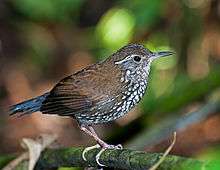Sharp-tailed streamcreeper
The sharp-tailed streamcreeper (Lochmias nematura) is a passerine bird of South America belonging to the family Furnariidae, the ovenbirds. It is the only member of the genus Lochmias. The species is also known as the streamside streamcreeper.[2]
| Sharp-tailed streamcreeper | |
|---|---|
 | |
| In São Paulo, Brazil | |
| Scientific classification | |
| Kingdom: | Animalia |
| Phylum: | Chordata |
| Class: | Aves |
| Order: | Passeriformes |
| Family: | Furnariidae |
| Genus: | Lochmias Swainson, 1827 |
| Species: | L. nematura |
| Binomial name | |
| Lochmias nematura (Lichtenstein, 1823) | |
| Subspecies | |
|
See text | |
Description
This bird is about 6 in (15 cm) long, with a short tail and a long, thin, slightly curved bill. The plumage is dark brown, densely spotted white on the underparts. There is a white stripe over the eye and the tail is blackish.
The first Guyana specimen, collected on July 24, 2004, had a smooth ovary measuring 4x3 mm, a bursa of Fabricius measuring 3x3 mm, and an unossified skull (as often seen in Furnarioidea even when adult).[3]
The song is an accelerating trill, lasting for about five seconds.
Ecology
It inhabits dense undergrowth near streams, particularly in humid premontane and montane forest,[4] foraging on the ground for insects and other invertebrates.[5] It usually occurs alone or in pairs and is often shy and hard to see. The nest is ball-shaped with a side-entrance and is built on the ground.
Due to its extremely wide range, the sharp-tailed streamcreeper is not considered a threatened species by the IUCN.[1][6]
Subspecies
There are six subspecies which differ little:
- Lochmias nematura castanonotus - south-east Venezuela
- Lochmias nematura chimantae - southern Venezuela
- Lochmias nematura nelsoni - Panama (eastern Darién)
- Lochmias nematura nematura - south-east Brazil, north-east Argentina, eastern Paraguay, Uruguay.
- Lochmias nematura obscuratus - Peru, Bolivia
- Lochmias nematura sororius - Colombia, Ecuador, northern Venezuela, north-east Peru
The species has long been suspected to have at least a temporary presence in Guyana. However, this was only proven recently, with sight records in the Pakaraima Mountains since 2002 and a specimen (LSUMZ 175389) taken in 2004. These birds probably belong to one of the Venezuelan populations, but it is not yet known to which.[3]
Footnotes
- BirdLife International (2012). "Lochmias nematura". IUCN Red List of Threatened Species. 2012. Retrieved 26 November 2013.CS1 maint: ref=harv (link)
- Remsem, (2003)
- O'Shea et al. (2007)
- Salaman et al. (2002)
- de L. Fávaro et al. (2006)
- BLI (2009)
References
- de L. Fávaro, Fernando; dos Anjos, Luiz; Lopes, Edson V.; Mendonça, Luciana B. & Volpato, Graziele H. (2006): Efeito do gradiente altitudinal/latitudinal sobre espécies de aves florestais da família Furnariidae na Bacia do Rio Tibagi, Paraná, Brasil [Effect of altitudinal/latitudinal gradient about forest ovenbirds species (Aves: Furnariidae) in the Tibagi river basin, Paraná, Brazil]. [Portuguese with English abstract] Revista Brasileira de Zoologia 23(1): 261–266. doi:10.1590/S0101-81752006000100020 PDF fulltext
- Remsen, V. (2003) Family Furnariidae (Ovenbirds). in del Hoyo J., Elliott A. & Christie D.A. (2003) Handbook of the Birds of the World. Volume 8. Broadbills to Tapaculos Lynx Edicions, Barcelona ISBN 84-87334-50-4
- O'Shea, B.J.; Milensky, Christopher M.; Claramunt, Santiago; Schmidt, Brian K.; Gebhard, Christina A.; Schmitt, C. Gregory & Erskine, Kristine T. (2007): New records for Guyana, with description of the voice of Roraiman Nightjar Caprimulgus whitelyi. Bull. B.O.C. 127(2): 118–128. PDF fulltext
- Salaman, Paul G.W.; Stiles, F. Gary; Bohórquez, Clara Isabel; Álvarez-R., Mauricio; Umaña, Ana María; Donegan, Thomas M. & Cuervo, Andrés M. (2002): New and noteworthy bird records from the east slope of the andes of Colombia. Caldasia 24(1): 157–189. PDF fulltext
Further reading
- Meyer de Schauensee, Rodolphe & Phelps, William H. (1978): A Guide to the Birds of Venezuela. Princeton University Press.
- Ridgely, Robert S. & Gwynne, John A. (1989) A Guide to the Birds of Panama with Costa Rica, Nicaragua and Honduras. Princeton University Press.
